Daphna Westerman’s Postcards in Motion
Did you find a postcard like this one in your mail box as well? Or have you even pulled the entire road movie by Daphna Westerman out of our Art Vending Machine? By now the Machine is sold out completely. But no need to stop the movie! Let’s just rewind a little…
Before the work of the Israeli artist ended up in the museum’s Art Vending Machine, I received a postcard with a black and white photograph. Except for my address and the title, “U-Bahn Berlin. From In and between the cities, 2011. A film by Daphna Westerman,” there was nothing more to it. A few days later more cards were in the mail. Time to phone Daphna.
Daphna, why didn’t you write anything on the postcards that you sent me?
I did not write anything on the postcards because I feel that the image speaks for itself. It does not need anything to be added. If I were to write something personal, this would be the main issue of the postcard instead of the postcard itself. I wanted the image itself to be the important thing. I wanted people to see the image, read the title and figure out what they want from it.
The cards show shots of Tel Aviv and Berlin in the years 2010 and 2011. What does the title “In and between the Cities/a film by Daphna Westerman” have to do with this?
When I began the project in 2010, I traveled a lot, mainly in Israel but also to Berlin, Germany, because of my work, my parents, and my friends. I carried my 35 mm camera with me wherever I went and documented every place. I took photos on the road, and in the cities, I took photos basically all the time. My first idea was to create a film out of these stills. I really love road movies. Particularly the road movies by Wim Wenders were an inspiration for this project – these journeys, during which his protagonists move around from one city to another, documenting what they see and never settling in one place.
You ultimately didn’t make a film but rather a photo-series. How did that happen?
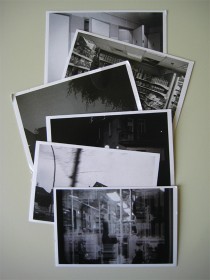
Fished from the mailbox of the Blogging team: Postcards from Daphna Westerman’s series “In and between the cities, 2011. A film by Daphna Westerman” © Jewish Museum Berlin, photo: Lisa Albrecht
When I looked at the photos during the work process something in the pictures made me think they were already part of an existing film. Every image is part of a bigger story, so that when you put all the images together you get the whole picture. For me, it is exactly like taking a frame out of a film. So I decided that it would not be necessary to make a real film of those pictures, when I can create a fictional one.
And why did you make post cards out of the photos?
The best way to conceptually continue my journey was to distribute the photos, to turn them into postcards and to send them to people. In doing so, the whole project developed into an existing film that gave people a sense of how it is like to be on a journey.
I consider the post as a public space but at the same time as an intimate one. It is important for me to approach people directly with my art. When people go to a gallery, they usually see pictures on a wall. I think there is a certain distance there that says: Now you are in a museum, now you are in a gallery. And that is much less personal than when you get work of art in your mailbox and it is addressed to you.
Visitors of the Jewish Museum Berlin did not necessarily find your post cards in their mailboxes, but they might have retrieved something from the Art Vending Machine: what was that?
It is a small notebook with ten postcards from Tel Aviv and Berlin. I invited the visitors who got the postcards to be a part of my art, to continue it, to use it as they want. In this case, it is not just my personal journey anymore; I am combining it with the journeys of the museum’s visitors.
What exactly should our visitors then do with the post cards?
Send them, of course! The postcards are not just to be hung on the wall! Pick a postcard, fill it out, put on a stamp, and go and put it in a mailbox. I wish that people will really address this work to someone. That way, they continue it. I mean: Just take it and do something with it!
And therefore one could understand your post card series as an interactive movie. What else are you working on? And which themes are important to you?
I am usually interested in the urban situation, the city life and how it affects us. In every project I do, I address this issue in a different way, from a different angle ‒ as I did for the art vending machine. But I think this project is not just about traveling the cities, it is also about the lack of roots and the feeling of not belonging to one place, the feeling of movement.
Where are you living right now and what are you currently working on?
I am working on a video piece that takes place in my studio in Tel Aviv which is actually a bunker. I’ve been renting this space from the municipality for low cost. It is a big space, and it has all kind of systems against chemical bombings and stuff like that. I guess it sounds strange but unfortunately for me it’s everyday life.
A while after we spoke on the phone, Daphna had to clear everything out of her studio in the bunker. She wrote me:
The video work is called “Four hours” and deals with the current situation. In case of war, me as an artist who’s using this space as a studio has only four hours to leave it and evacuate all my equipment, so that the people who live in the area can use it as a bunker. And that is what happened during the making of this piece, when another war in Gaza started.
Daphna Westerman could have withdrawn into her studio by now, but in October she began a Master’s Program in Weimar. Much success, Daphna!
You can find out more about Daphna Westerman’s work in the Art Vending Machine here, in German.
Lisa Albrecht, Media
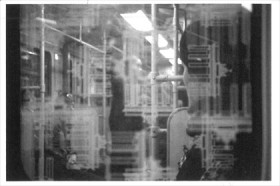
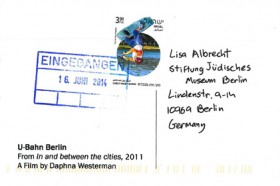
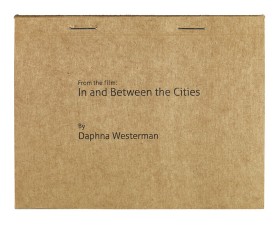
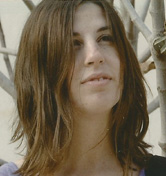
Daphna i want one, too!
yehudit A